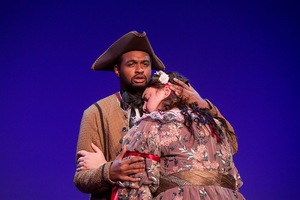The Saint Paul Chamber Orchestra, under the direction of their new music director Andreas Delfs, returned for a visit to Page Auditorium under the auspices of the Duke Artists Series – but with a twist. The orchestra brought with them the Théatre de la Jeune Lune, a joint Paris-Minneapolis modern dance and mime company.
Igor Stravinsky’s Pulcinella Suite started life as a ballet for Sergey Diaghilev’s Ballets Russes in 1919. The music is based on manuscripts copied by Diaghilev from scores in the libraries of London and Naples most of them mis-attributed to Pergolesi. They were mainly compositions by the obscure 18th century composers Domenico Gallo and Carlo Ignazio Monza as well as the Dutch nobleman Count Unico Wilhelm van Wassenaer. Stravinsky gave these fragments a clean, lean, modern orchestration, put in a few “wrong notes,” retired the monotonous regularity of phrases by some unexpected tempo and key changes; in these small adaptations he changed the whole character of the music.
The story of the ballet is based plots from the Commedia dell’arte, which emerged early in the 16th century as an improvisatory street theater, a parody of Venetian and North Italian society. It incorporated elements of mime, acrobatics, slapstick, music and dance. Pulcinella himself was a mischievous grotesque clown with a long nose.
The six dancers of the Théâtre de la Jeune Lune clowned, mimed and danced a modern adaptation of the old comedy. The farce involved a pair of bumbling lovers and four impish “facilitators” wearing white high hats and black masks, whose attempts, full of pratfalls, to help the lovers get together, caused one disaster after another until at the end they triumphantly delivered the beau to his girl in a box of red roses. While their slapstick was in places a little excessive, their costumes, movements and miming were outstanding and added a lot of zip to a somewhat bland and sweet performance by the orchestra. Delfs rounded out all the corners, obliterating the Stravinsky’s characteristic musical “bite.”
The same blandness pervaded Edvard Grieg’s Holberg Suite , dedspite Delfs’s excessive gesturing as he tried to mold every little phrase. The Saint Paul’s musicians are first-class professionals and certainly know what a diminuendo is without requiring the conductor to show them by lowering his hand nearly to the floor. Nor do they have to have a pianissimo illustrated by his touching his lips with his index finger. He appeared to be conducting for the benefit of the audience but succeeded only in providing an annoying distraction from the music.
A bonus of two movements from William Walton’s Façade, again with the Théâtre de la Jeune Lune dancers, was a delight. In stylized 1920s costumes that made them appear headless but with bowler hats perched on their shoulders, the mimes left the audience in stitches with their antics. Walton and the Sitwells would have been delighted.
A lively and “fire truck chasing” performance of Mozart’s Symphony No.39 in E-flat made up the second part of the concert. The precision and balance of the orchestra were exemplary, but again, Delfs’s balletic gyrations detracted from the enjoyment of what was otherwise an outstanding reading.
Delfs is potentially is an excellent conductor. Maybe when St. Paul’s returns, he should join the dancers.











